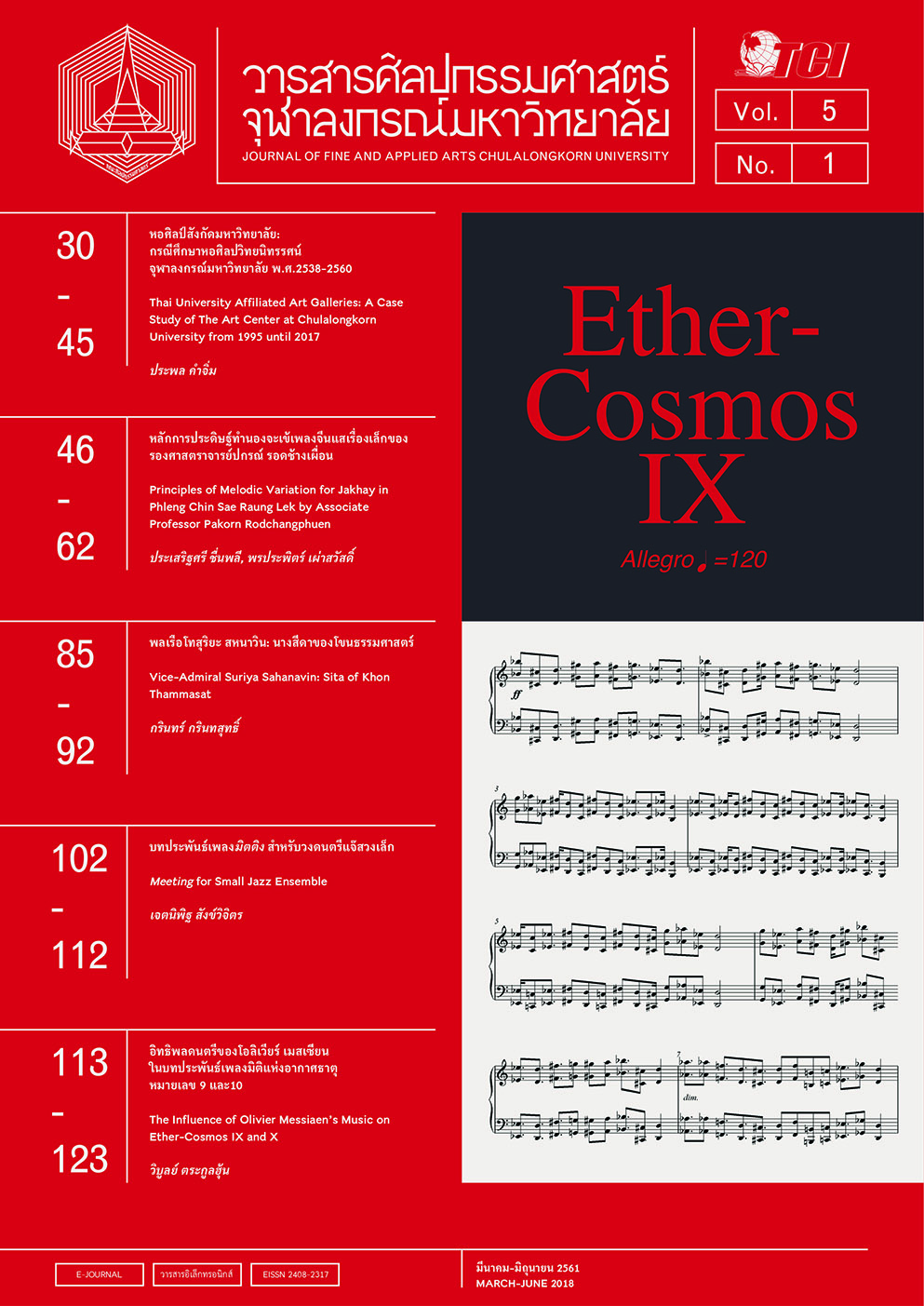การฝึกหัดและการถ่ายทอดกระบวนรำกราวนางยักษ์
Keywords:
กราวนางยักษ์, การถ่ายทอด, กระบวนรำ, การฝึกหัด, ข้อควรคำนึงถึง, Kraw Nang Yak, Transmission/ Dance, Training, ReflectionsAbstract
การรำกราวนางยักษ์เป็นการรำที่สำคัญสำหรับผู้แสดงที่รับบทบาทนางยักษ์ในการแสดงโขนและละครรำของไทยผู้รับบทบาทนางยักษ์ทุกคนต้องรำเพลงนี้ได้ซึ่งการรำกราวนางยักษ์มีขั้นตอนการฝึกหัดได้แก่การฝึกเต้นเสาการฝึกหัดท่ารำตามแบบฉบับโขน การรำกราวนางยักษ์เป็นการรำที่สำคัญสำหรับผู้แสดงที่รับบทบาทนางยักษ์ในการแสดงโขนและละครรำของไทยผู้รับบทบาทนางยักษ์ทุกคนต้องรำเพลงนี้ได้ซึ่งการรำกราวนางยักษ์มีขั้นตอนการฝึกหัดได้แก่การฝึกเต้นเสาการฝึกหัดท่ารำตามแบบฉบับโขน การถ่ายทอดกระบวนท่ารำเพลงกราวใน และการฝึกหัดจริตกิริยาแบบตัวนาง ซึ่งในกระบวนการฝึกหัดและถ่ายทอดกระบวนท่ารำนั้นมีข้อควรคำนึงหลายประการที่มีผลต่อการถ่ายทอดท่ารำ ได้แก่ ความชอบและความสนใจของผู้รับการถ่ายทอด ทักษะของผู้รับการถ่ายทอด วิธีการถ่ายทอดของผู้ถ่ายทอด และระยะเวลาในการถ่ายทอด ซึ่งส่งผลให้กระบวนการถ่ายทอดไม่มีประสิทธิภาพเท่าที่ควร ดังนั้นเพื่อให้การถ่ายทอดมีประสิทธิภาพควรคำนึงถึงคุณสมบัติที่เหมาะสมของผู้รับการถ่ายทอด ทักษะที่ดีของผู้รับการถ่ายทอด การฝึกหัดตามขั้นตอน และสำหรับการเรียนในชั้นเรียนควรคำนึงถึงการคัดเลือกบทเรียนที่เหมาะสมในการสอน ซึ่งการฝึกหัดเพลงกราวนางยักษ์นับเป็นส่วนสำคัญของการพัฒนาทักษะทางการแสดงบทบาทนางยักษ์ให้มีความชำนาญ เพราะเป็นเพลงหน้าพาทย์สำคัญที่บทบาทนางยักษ์แทบทุกบทต้องใช้ในการแสดง
Kraw Nang Yak Dance is essential to dancers who perform the role of Nang Yak (Female Demon) in the performance of Khon and Thai classical dance drama. All Nang Yak dancers must be able to perform this dance. The training steps of Kraw Nang Yak Dance include the practicing of dance movements for the pole dance, Khon dance and Krawnai dance as well as the practicing of the distinctive movements and demeanors of the female characters in Thai classical dances. The training and transmission process of the dance movements of this dance have created several problems with significant impacts on the transmission of Kraw Nang Yak dance movements. These reflections originated from such factors as the passion and interest of dance trainees in the dance, their dance skills, trainers’ transmission technique and the length of training. These factors can render the training process less efficient than it should be. Therefore, to ensure efficient transmission of dance movements, trainers should take into consideration the appropriate qualifications and skills of dance trainees as well as the suitability of the training steps. For class instruction, special attention should be given to the selecting of suitable dance lessons for students.
Downloads
Published
Issue
Section
License
ลิขสิทธิ์ของบทความเป็นของเจ้าของบทความ บทความที่ได้รับการตีพิมพ์ถือเป็นทัศนะของผู้เขียน
กองบรรณาธิการไม่จำเป็นต้องเห็นด้วยและไม่รับผิดชอบต่อบทความนั้น






